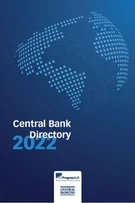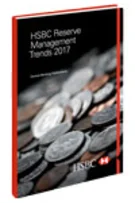Executive summary
Executive summary
Executive summary
Trends in reserve management: 2022 survey results
Interview: Gerardo García
Central bank digital currencies: 10 questions
Rethinking equity investing at the National Bank of Austria post-2020
How can reserve managers escape low yields – and stay true to their mandate?
Reserve managers weigh the risks amid the Ukraine crisis
Appendix 1: Survey questionnaire
Appendix 2: Survey responses and comments
Appendix 3: Reserve statistics
This book, HSBC Reserve Management Trends 2022, the 18th annual edition, is published at a time when reserve managers around the world are re-evaluating their assumptions for the year following Russia’s invasion of Ukraine.
For reserve managers, the tragic events will impact markets, most notably their liquidity and volatility, and in the longer term inflation, and by extension monetary policy. More broadly, it will lead to a recalibration of geopolitical risk, with implications for choices around currency and custody.
2022 survey findings
The first chapter presents the findings of a survey carried out in February and March 2022 of 82 reserve managers responsible for $7.3 trillion in reserves. As a group, reserve managers in 2022 are most concerned about the risks of rising inflation and monetary policy normalisation. These two risks dominate the views of those who took part in the survey. The survey was already underway on February 24, and indeed half of the responses had been received by then, when Russia invaded. Responses after this date naturally show more apprehension about geopolitical risks, but those two concerns remain the focus.
A clear finding of the survey is that central banks will continue to diversify reserves even as yields rise. Non-traditional reserve assets are a growing and important part of a reserve manager’s toolkit, and the survey shows that a significant minority of respondents have changed their holdings in the past year or plan to do so in 2022. In this vein, exchange-traded funds (ETFs) are emerging as an important component, especially for those looking for exposure to equities. Reserve managers continue to diversify, showing increasing appetite for green bonds, social and sustainability bonds, and equities in particular.
Support for non-traditional currencies continues to increase also, with the onshore renminbi especially increasing in the number of converts. When investing in the renminbi, reserve managers typically look to government bonds, but there is growing interest in policy bank bonds.
In addition, there is mounting interest in central bank digital currencies (CBDCs). Reserve managers see CBDCs as having an impact on reserve management in the long run, especially in an operational context. Support for socially responsible investing (SRI) is also gaining momentum, with a significant majority of respondents either incorporating an element in their reserve management or actively considering it.
A view from Mexico
Chapter 2 presents an exclusive interview with the head of reserves at the Bank of Mexico, Gerardo García. The interview covers three broad themes: the outlook for 2022; the Bank of Mexico’s possibly unique approach to asset allocation; and the central bank’s approach to diversification.
On the first, García explains how Russia’s invasion of Ukraine will likely affect markets and how their reserves team is responding. There are a number of dilemmas facing the reserve manager in the market conditions of March 2022, but he concludes by noting that the medium-term effect may in fact be to reinforce the macroeconomic trends that were already in place, around tightening and monetary policy normalisation. Assets that offer protection against inflation and markets whose economic cycles are going in the opposite direction will be the focus, he points out.
Essential to this outlook is the Bank of Mexico’s approach to asset allocation, which uses market prices rather than historical data. The journey to this process has not been a straightforward one, as García explains, but has resulted in two clear gains for the central bank. First, it has meant the reserves team can put “robust propositions” to the board for consideration. Second, there has been the enhanced performance of the portfolio.
The motivation for this change was concern over capital losses as the central bank’s reserves had increased significantly in the first decade of this century. However, as García puts it: “Being focused on capital preservation doesn’t mean that return is unimportant,” and the central bank has explored new currencies in particular. While equities remain, for the time being at least, a step too far, the central bank has experimented with an absolute return programme, which has proved a notable success.
CBDC questions
That reserve managers are interested in CBDCs there can be little doubt. The survey in this edition and also in last year’s edition attest to this. Yet, CBDCs tend, at least in 2022, to raise more questions than they answer. This theme is picked up in Chapter 3 by Paul Mackel, James Pomeroy and Zoey Zhou of HSBC. Indeed, ten questions raised by and for central banks form the backbone of the chapter.
The authors focus on design, issuance and the market, and begin by making an insightful and useful distinction between a CDBC and a cryptocurrency. Indeed, the diagram in Figure 3.2 on page 65 should be required viewing for market participants and central bankers alike. Importantly, the authors note the difference in environmental impact. They then discuss the decision a central bank will need to make as to whether a direct or indirect model is followed: indirect seems favourite at present.
In terms of issuance, timelines vary, but emerging markets are clearly in the vanguard. The authors note that a handful have become available, but that these projects – while interesting – are relatively small. Pilots and projects are underway in the larger economies of India and Brazil; among advanced countries, the authors offer this pithy summary: “While the PBoC [People’s Bank of China] is leading the charge among the world’s biggest central banks, things have been much slower for its developed world counterparts.” Sweden is a long way out in front, and the experience of the e-krona will provide many lessons for developed country central banks, the authors conclude.
With regard to the market, the authors note the interest, especially among central banks in Asia, and the potential for cross-border use. Where does this leave the reserve manager? The authors view CBDCs in particular as part of a move towards currency diversification, but with efficiencies built in. They conclude: “The role of the US dollar as the world’s reserve currency could be impacted if other countries moved ahead with their CBDC development, and those CBDCs prove to be more attractive than the existing forms of the dollar.”
Rethinking equities
In Chapter 4, Franz Partsch of the National Bank of Austria provides an update on the thinking at his central bank around investing in equities. The move of reserve management into this asset class is a trend this publication has keenly followed, both in surveys and chapter contributions over the years.
The chapter begins by charting the central bank’s experience with equities, noting that it had used the asset class prior to it becoming a reserve asset when it was included in their pension funds. There are two key staging points here: 2008 and 2020 – at both points, the central bank took the view that it needed to increase equity exposure.
The author discusses the process that led to the change in 2021, in particular the material necessity to convince the board to increase equity exposure. Key here was not just to present a number of alternative scenarios, but to show the danger of what the author describes as the “do nothing scenario”. Thus, the board was more open to the alternatives but, as the author notes, the reserves team also had to show the impact the change would have not just on the portfolio but the central bank’s P&L: “We had to show how we could use the balance sheet to smooth the effect of negative events over time,” Partsch writes.
A final element mentioned is ETFs. Their use has increased among reserve managers over the past few years, and this year’s survey shows reserve managers’ enthusiasm for them. In Vienna, Partsch notes, ETFs have been used in two contexts. First, obviously, to gain exposure to smaller markets or when starting out in a market. Second, when changing mandate or external manager.
Diversification: a contrarian view
Chapter 5, by Mario Torriani of the Central Bank of Argentina, takes somewhat of a contrarian view on diversification. He begins by noting an anomaly: that the reason for holding reserves – self-insurance from shocks – is absent from the decision-making process in their allocation. By employing what Torriani calls a “non-contingent framework”, reserve managers will look solely at the performance of the financial assets. Yet, as he argues, central banks face contingent liabilities associated with their policy role that will have an effect on the portfolio. These could well be greater than the movement of the prices of the portfolio assets themselves.
This approach has several negative outcomes for reserve management, Torriani maintains. First, the reserves invested in are worth less than they could be when they are needed, as their value in a crisis has been discounted or not taken into consideration. Second, concern over reputational risk associated with short-term losses means assets that perform well in a crisis, such as longer-term bonds, are avoided. Third, when a shock hits reserve management may be at odds with other central bank policies, and the reserve manager may in fact behave procyclically.
Does this mean that a reserve manager shouldn’t diversify? That they should stick to long-term government bonds? Not so, writes Torriani, who offers possible avenues through currencies and covered interest parity for the reserve manager to earn extra yield without working against the stated aim of self-insurance.
Ukraine crisis
Chapter 6 draws on a recent Central Banking event to present views from reserve managers on the impact of Russia’s invasion of Ukraine. The event was held under the Chatham House rule and took place on March 29. In addtion to the macroeconomic and market impacts, the chapter notes the shift towards a “weaponisation” of central bank reserves, a new development in international finance with reserves belonging to Afghanistan and Russia being seized and blocked, respectively.
Inflation protection was the first order of the day, with the “traditional” route of inflation-protected securities now complemented by ETFs. The latter would enable a central bank to gain exposure to a number of sectors, central bankers speaking at the event noted: “You can access them through an ETF at very low cost. And you don’t even have to enter into lengthy legal negotiations for passive mandates. There’s public infrastructure, exposure to energy or mining and metals.” Though as was noted later on this might mean that some reserve managers could be required by their boards to explain whether higher exposure to these sectors was in line with environmental social and governance (ESG) principles.
Central banks have been called upon to act in other ways. The National Bank of Poland stepped in to help refugees exchange their Ukrainian currency and the European Central Bank provided a swap line to support the Polish central bank. Central banks globally acted to seize the Bank of Russia’s reserves as part of international sanctioning This last aspect raises questions for the international monetary system and the preference for reserve currencies. Intriguingly, as some suggest, a winner may not be a currency in fact but a crypto.
____________
On behalf of Central Banking, I would like to thank all who contributed to this year’s book, both as authors and survey respondents. As ever, the editors welcome comments on this year’s book and suggestions for future editions.
We would like to express our thanks to Bernard Altschuler and his colleagues at HSBC for their continued support of this title.
Nick Carver
London, April 2022
Only users who have a paid subscription or are part of a corporate subscription are able to print or copy content.
To access these options, along with all other subscription benefits, please contact info@centralbanking.com or view our subscription options here: http://subscriptions.centralbanking.com/subscribe
You are currently unable to print this content. Please contact info@centralbanking.com to find out more.
You are currently unable to copy this content. Please contact info@centralbanking.com to find out more.
Copyright Infopro Digital Limited. All rights reserved.
As outlined in our terms and conditions, https://www.infopro-digital.com/terms-and-conditions/subscriptions/ (point 2.4), printing is limited to a single copy.
If you would like to purchase additional rights please email info@centralbanking.com
Copyright Infopro Digital Limited. All rights reserved.
You may share this content using our article tools. As outlined in our terms and conditions, https://www.infopro-digital.com/terms-and-conditions/subscriptions/ (clause 2.4), an Authorised User may only make one copy of the materials for their own personal use. You must also comply with the restrictions in clause 2.5.
If you would like to purchase additional rights please email info@centralbanking.com











